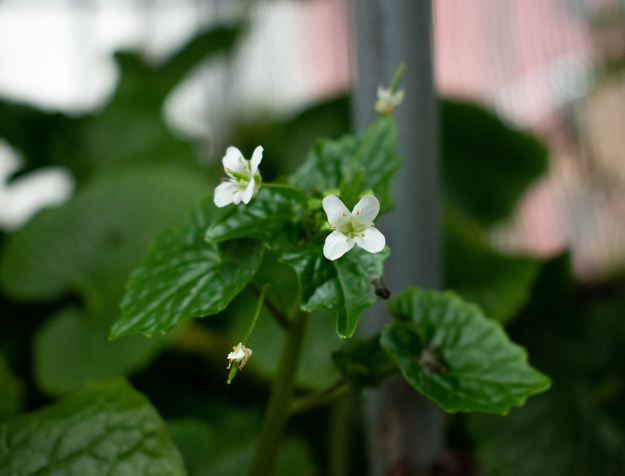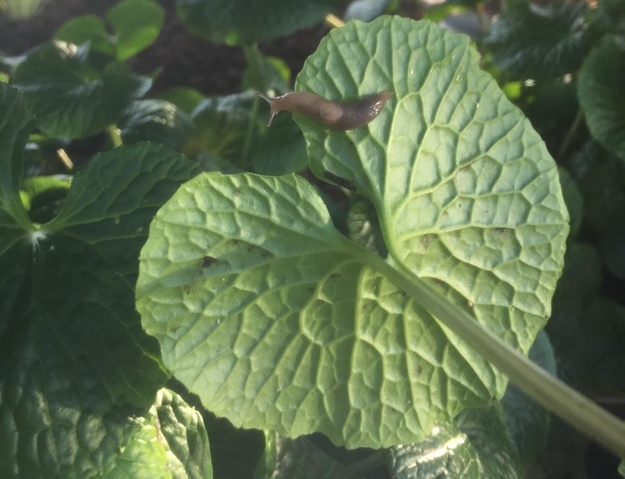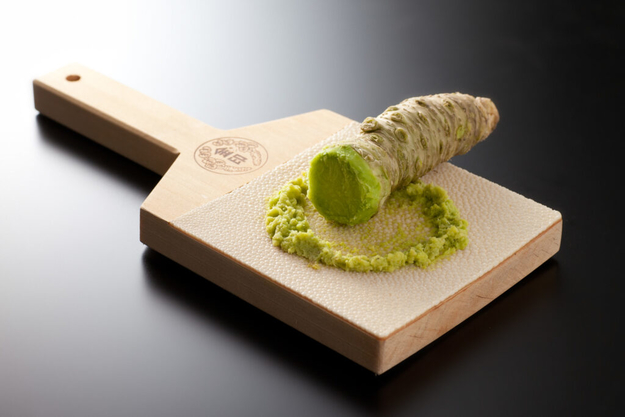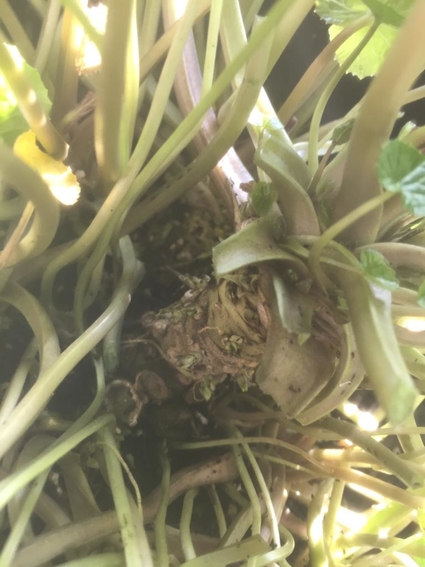Our Wasabi Japonica journey
The Wasabi in aquaponics was planted by previous interns in the spring of 2021, after the first attempt in 2020 failed because of a snail invasion. Even though it wasn’t a one-hit-wonder, it’s quite special that we now have fully grown plants in aquaponics. There’s a lot of secrecy around the tips and tricks to successfully grow Wasabi, and farmers that wrapped their heads around it are selling their knowledge for high prices. For us the process of growing Wasabi was very much based on trial and error, which makes us extra happy to see the plants flower for the second time.
Last February, the Wasabi plants flowered for the first time, which was a sign that we were going in the right direction. However, Wasabi is a slow grower, so the fact that the plant was flowering last year did not mean that it was ready to have its most desirable part harvested. The most lucrative part of the Wasabi is the rhizome, which grows underground like Ginger or Turmeric. On average it takes 2 years to grow a sizable rhizome that can be harvested. The combination of its slow groth and difficult cultivation make that Wasabi rhizomes sell for about 350 euros per kilo. Since we are approaching the 2 year mark, it means that I am in the lucky spot to review if the Wasabi rhizomes are almost ready to be harvested. If so, some visitors of the restaurant will be fortunate enough to try the real deal.
How to harvest?
The central rhizome of the plant can be harvested once it is 10-15 cm in length and 1.5-2.5 cm in diameter. To harvest, the entire plant should be pulled out of the ground, and the rhizome will appear. There will be small plantlets on the rhizome, which can be removed with a sharp knife, and can be replanted. This saves you the hustle of going through the most tricky stage of growing Wasabi: the germination.
Even though the showstopper of the Wasabi plant is the rhizome, all parts of the plant are edible. The leaves, stems and flowers can be harvested before the rhizome is fully grown and they all have an interesting taste. It is possible to cut away a big part of the leaves, but the young, curly, reddish leaves that grow from the center of the crown should be left intact. It is also advisable to leave some flowers, so eventually the seeds can be collected. When harvesting the leaves and flowers this way, the growth of the plant or the rhizome will not be affected. In fact, cutting away some of the leaves and flowers (pruning) may result in a fuller, healthier plant.
Wasabi in the Kitchen
The kitchen team has already used the flowers, leaves and stems in some dishes at Mediamatic ETEN. These parts do not only look stunning, they have a beautifully bitter and faintly spicy taste, as if they playfully hint towards what we are actually waiting for. The stems and leaves can be eaten raw, pickled (sake kasu), blanched, or fried. However, the heat is preserved the most when Wasabi is eaten raw.
As opposed to the easy preparation of the leaves, stems and flowers; using the rhizome requires a bit of a manual. To enjoy the taste of the Wasabi rhizome to the fullest it has to be grated freshly on the plate. Traditionally this is done with a special sharkskin grater (which we will have to find an alternative for as Mediamatic ETEN is a plant-based restaurant). After grating, the pungent heat only lasts for about 15 minutes. This fact reveals that most of us are fooled into thinking we have ever tasted real Wasabi. The fluorescent green paste you buy in a store is a replica made from horseradish, and is noticeably different from real Wasabi. The taste of fresh Wasabi is zingy, herbal and spicy, with a heat that is much more delicate than the Wasabi paste most of us are used to. This heat doesn’t blast away the taste of the other elements on the plate, but rather elevates it.
Interestingly enough, Wasabi wasn’t originally loved for its spicy taste, but more so for its medicinal properties. The story goes that Wasabi was often eaten with raw fish to prevent food poisoning, as it has anti-bacterial and stomach calming properties. This is why it is hard for most of us to imagine sushi without its spicy counterpart. At Mediamatic ETEN, you can expect to experience Wasabi in a different plant-based context, where it will be celebrated for its versatility in use, delicate taste and temperamental personality.
Beet and Wasabi - Gino's beet and wasabi masterpiece. You'd almost forget it is still winter.
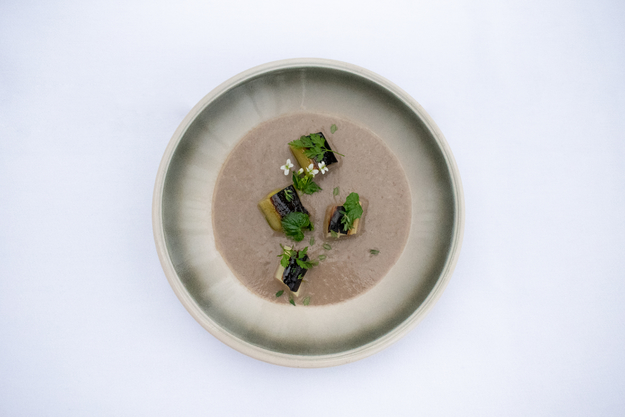
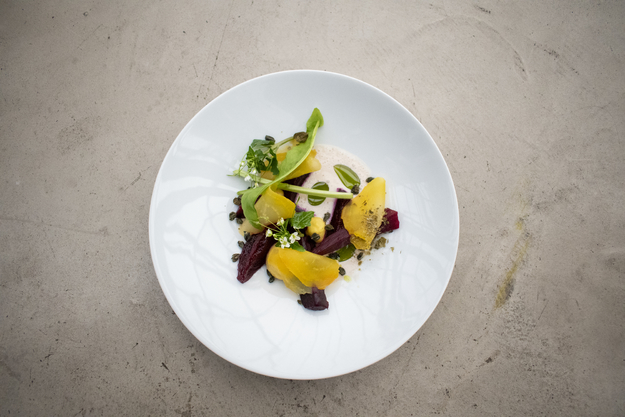
Rhizome update
This finally brings us to the most important part of this article. How is our Wasabi doing? In our greenhouse, the plants grow in different growing mediums and with different exposures to sunlight (and therefore different temperatures). We tried this to gather more accesible information about ways to succesfully grow this fussy plant. For reference, read this article. All of our plants have healthy leaves and grow flowers, so there is not too much of a difference between the different growing conditions. We do find that the Wasabi grows better in the lower growbeds, with more shade and lower temperatures.
In one of the lower growbeds we pruned three Wasabi plants. We did this for two reasons; to find out how quickly leaves regrow after cutting, and to take a better look at the rhizomes. Above ground, the three plants all show sizeable Rhizomes of about 1.5 cm in diameter. This is exciting because it means that they are technically big enough to be harvested. It is hard to compare the size and quality of the rhizomes of the different plants before harvesting them, because we don't see what is going on underground. Even though they are technically ready to be harvested, we decided to wait a bit longer to see if we can grow them even bigger, because green = gold.
Sources:
https://www.bbc.com/news/business-29082091
https://pithandvigor.com/2017/10/growing-wasabi-garden-nerds-challenge/#:~:text=Harvest%20when%20the%20central%20rhizome,replanted%20for%20the%20next%20harvest.
https://www.thewasabistore.com/thewasabistore/29wlr2gk6h89ky5xak9xehpfr63x8w
